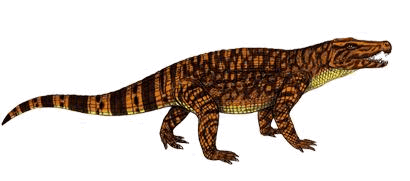Quinkana
Quinkana - the crocodile that walked on land

https://en.wikipedia.org/wiki/Quinkana
The Crocodile that walked on land
Quinkana is an extinct genus of mekosuchine crocodile that lived in Australia from 24 million years ago to 40,000 years ago.
Unlike modern crocodiles with a sprawling stance Quinkana carried itself clear from the ground, facilitating running over terrain.br Additionally Quinkana had serrated, blade like teeth rather than typical crocodiyliform conical teeth.br This is likely because aquatic crocodiles need to capture their prey in order to drown them in the waterway.
Hunting away from water Quinkana must be able to inflict grievous injuries to prey with its bite alone, sufficiently injuring prey so that even if they escape they will succumb to the wound.
The terrestrial crocodile had relatively long, agile legs, very different from the splayed limbs of modern crocodiles, and its teeth were curved and sharp, like those of a tyrannosaur dinosaur.
By the Pleistocene Quinkana had become one of the top terrestrial predators of Australia, possessing long legs and ziphodont teeth (lateromedially compressed, recurved and serrated).
Unlike today's Australian crocodiles, this large 220kg land-dwelling reptile's long legs made it a fast hunter.
It tired out its prey of mammals, birds and other reptiles in long chases. Its sharp teeth allowed it to tear apart its prey, unlike its water-dwelling surviving cousins whose teeth are better suited to holding and drowning their prey. Quinkana belonged to a group of crocodiles (mekosuchines) that are now all extinct. Quinkana comes from the 'Quinkans', a legendary folk from Aboriginal myths.

There are two main features of Quinkana that suggest a terrestrial lifestyle.
1. First are the legs that are better able to support and carry the body clear off the ground.
Most of the crocodiles we know today are primarily aquatic and are only able to push themselves along on their bellies.
2.The second feature is the type of tooth. Aquatic crocodiles typically have conical teeth that are very good for holding onto struggling prey as they drown it underwater.
However, because it lived on the land, Quinkana could not use water to drown its prey, so conical teeth would be of limited use.
Instead the teeth were more like knives, compressed laterally and with serrated edges.
This means that a bite from Quinkana would do a lot of damage to a softer bodied prey item like a mammal.
Even if the prey survived the initial attack and escaped it would probably succumb to shock and blood loss in a short space of time, meaning Quinkana would just have to bide its time until the prey was too weak to escape.
Earth Science undertook 14 fossil expeditions including a site adjacent to the discovery site of quinkana
https://thebestwill.wordpress.com/2018/11/19/a-z-prehistoric-life-quinkana/
deviantart.com SameerPrehistoric
http://www.prehistoric-wildlife.com/species/q/quinkana.html
Learn more about FOSSIL BASICS and HOW TO MAKE A SIMPLE FOSSIL COLLECTION

